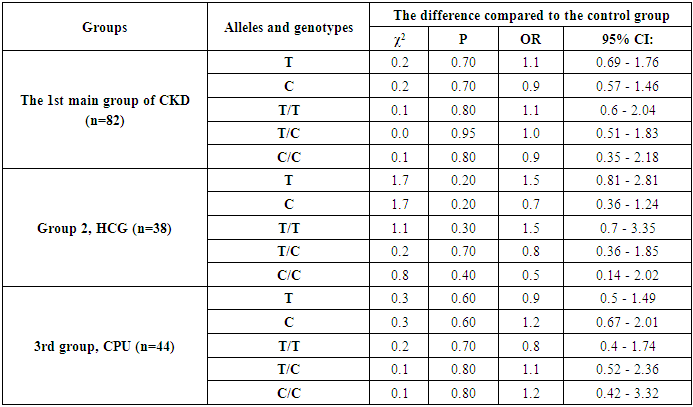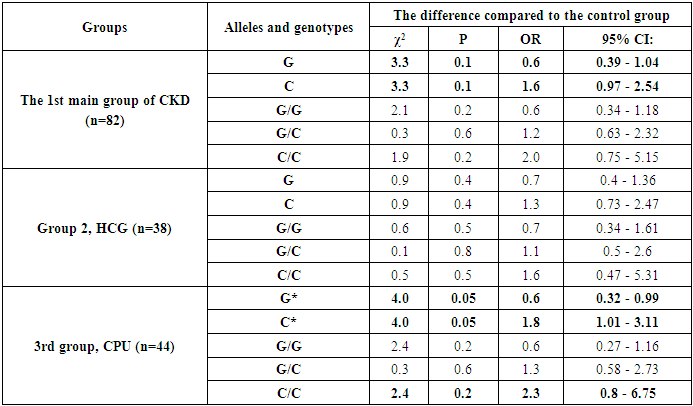-
Paper Information
- Next Paper
- Previous Paper
- Paper Submission
-
Journal Information
- About This Journal
- Editorial Board
- Current Issue
- Archive
- Author Guidelines
- Contact Us
American Journal of Medicine and Medical Sciences
p-ISSN: 2165-901X e-ISSN: 2165-9036
2025; 15(3): 535-538
doi:10.5923/j.ajmms.20251503.09
Received: Jan. 23, 2025; Accepted: Feb. 22, 2025; Published: Mar. 8, 2025

Assessment of the Significance of a Number of Cytokine Gene SNP in Chronic Liver Diseases
Sadikov S. B.1, Abdullaev R. B.1, Matkarimova D. S.2
1Urgench Branch of the Tashkent Medical Academy, Tashkent, Uzbekistan
2Tashkent Medical Academy, Tashkent, Uzbekistan
Copyright © 2025 The Author(s). Published by Scientific & Academic Publishing.
This work is licensed under the Creative Commons Attribution International License (CC BY).
http://creativecommons.org/licenses/by/4.0/

Taking into account the structural and functional features of the IL1b (T-31C) and IL6 (C-174G) genes, to evaluate their significance in chronic liver diseases. The material for the study included 82 patients with CLD (main group 1) and 80 healthy, without liver disease (control group 4). The median age of the examined patients was 53.3±1.4 years old. In addition to standard studies (clinical, instrumental, and laboratory), molecular biological methods (detection of IL1b (T-31C) and IL6 (C-174G) genes) were performed in the study groups. by SNP-PCR on a programmable thermal cycler Rotor Gene (Quagen, Germany), using test systems from Litech (Russia). Statistical calculations of the obtained results were performed using the statistical software package OpenEpi 2009, Version 9.2. In the course of molecular genetic analyses in CLD, functional activity was established in relation to the risk of CLD and the aggravation of their course with the transition to CP for weakened loci (C and C/C) of the IL6 polymorphic gene (C-174G).
Keywords: Chronic liver diseases, Chronic hepatitis, Cirrhosis of the liver, IL1b (T-31C) gene polymorphism, IL6 (C-174G) gene polymorphism, Polymorphic loci, Structure, Functional activity
Cite this paper: Sadikov S. B., Abdullaev R. B., Matkarimova D. S., Assessment of the Significance of a Number of Cytokine Gene SNP in Chronic Liver Diseases, American Journal of Medicine and Medical Sciences, Vol. 15 No. 3, 2025, pp. 535-538. doi: 10.5923/j.ajmms.20251503.09.
1. Introduction
- Chronic liver disease (CLD) is characterized by prolonged chronic damage to the parenchyma due to the constant effects of the inflammatory process and [1,2,6]. CLD is a serious problem for public health worldwide, as it affects more than 800 million people, with an annual mortality rate of about 2 million cases from CLD [5]. The mechanisms of formation of chronic liver diseases (CLD) are complex [3,17] and are associated with a stable inflammatory response leading to damage to liver tissues [7,11,14].The literature provides evidence that genetic factors play an important role in the severity and long-term prognosis of CLD [2,5,10,12,15]. Polymorphic interleukin genes IL1b (T-31C) and IL6 (C-174G) are one of such genetic factors considered as the most important immune regulator in CLD [1,4]. According to some researchers, in the process of liver damage, polymorphic genes function to create the basis for maintaining inflammatory reactions in liver tissue by disrupting immune regulation [8,9,13]. In both scientific and practical terms, information about the contribution of genetic factors influencing the development of CLD and the progression of their course is important today, since they are key points in understanding the main mechanisms of CLD formation [16,17]. In turn, this lays the foundation for early prediction of the severity of CLD, as well as for the development of the most effective methods of their treatment.Purpose. Taking into account the structural and functional features of the IL1b (T-31C) and IL6 (C-174G) genes, to evaluate their significance in chronic liver diseases.
2. Material and Methods
- 82 patients with CLD (the 1st main group) and 80 healthy, without liver diseases (the 4th compared control group) served as the material for the study. The median age of the examined patients was 53.3±1.4 years old. The main group of patients with CLD, depending on the nosology, is divided into two groups: 2 (n=38) - patients with chronic hepatitis (HCG) and 3 (n=44) with cirrhosis of the liver (CP). All patients who gave informed consent to participate in the study were monitored and inpatient treatment for chronic liver diseases at the Khorezm Regional Multidisciplinary Medical Center (Urgench) in the period from 2020 to 2023. In addition to standard studies (clinical, instrumental, and laboratory), molecular biological methods (detection of IL1b (T-31C) and IL6 (C-174G) genes) were performed in the study groups. by SNP-PCR on a programmable thermal cycler "Rotor Gene" (Quagen, Germany), using test systems from Litech (Russia). The distribution of observed and expected genotype frequencies of the studied polymorphic gene was compared in accordance with the Hardy-Weinberg equilibrium (RHB) (P>0.05), a comparative analysis of polymorphic loci of IL1b (T-31C) and IL6 (C-174G) genes between groups of patients and healthy subjects was carried out by calculating the criterion of χ2, reliability (P), the probability of development (OR) and the confidence interval (95% Cl). The revealed differences were considered significant at P<0.05. Statistical calculations of the results were performed using the statistical software package "OpenEpi 2009, Version 9.2".
3. Results and Discussion
- Analyzing the distribution features of the observed (But) and expected (Not) genotypes for polymorphic genes IL1b (T-31C) and IL6 (C-174G), as well as their correspondence to the Hardy-Weinberg (HWE) equilibrium, it was found that there were no discrepancies from their canonical distribution in the control group (χ2<3.84; P>0.05) and the main one with CLD groups (χ2<3.84; P>0.05).A two-way comparative assessment of the difference between the frequencies of IL1 β (T-31C) gene loci showed that in the main group with CLD, when compared with a healthy sample, the weakened C allele was less common than one (29.9% vs. 31.9%; χ2=0.2; P=0.7; OR=0.9; 95%CI: 0.57 - 1.46), and the main T allele was recorded 1.1 times more often (70.1% vs. 68.1%; χ2=0.2; P=0.7; OR=1.1; 95%CI: 0.69 - 1.76). At the same time, weakened T/C genotypes (35.4% vs. 36.3%; χ2<3.84; P=0.95; OR=1.0; 95%CI: 0.51 - 1.83) and C/C (12.2% vs. 13.8%; χ2=0.1; P=0.8; OR=0.9; 95%CI: 0.35 – 2.18) among patients with CLD were also less common, and the main T/T genotype, on the contrary, was 1.1 times more common (52.4% vs. 50.0%; χ2=0.1; P=0.8; OR=1.1; 95%CI: 0.6 - 2.04) (Table 1).Analysis of the functional significance of polymorphic IL1 β (T-31C) gene loci in CKD.
|
|
4. Conclusions
- Thus, taking into account the conflicting opinions regarding the role of IL1 β (T-31C) and IL6 (C-174G) gene polymorphisms in the pathogenesis of CLD, we performed their molecular genetic analysis with the study of structural and functional features in chronic liver diseases (CKD).The results of the evaluation of the distribution of IL1 β (T-31C) gene polymorphism loci in samples of patients with CLD and healthy individuals revealed differences between the groups. Along with this, the statistically unreliable nature of the differences in CKD in relation to healthy people (χ2<3.84; P>0.05) proves the low independent functional role of the studied genetic marker in the mechanisms of CKD formation. The results of the analysis of the IL6 (C-174G) gene allowed us to establish a pronounced tendency to increase the risk of CLD by 1.6 times (χ2=3.3; P=0.1), as well as a statistically significant association with an increased risk of developing CP by 1.8 times (χ2=4.0; P=0.05) when carrying the mutant allele C. and there is a slight tendency to increase the risk of CP by 2.3 times (χ2=2.4; P=0.2) in individuals with a C/C mutant genotype.Consequently, in the course of molecular genetic analyses in CLD, functional activity was established in relation to the risk of CLD and the aggravation of their course with the transition to CP for weakened loci (C and C/C) of the IL6 polymorphic gene (C-174G).
 Abstract
Abstract Reference
Reference Full-Text PDF
Full-Text PDF Full-text HTML
Full-text HTML
